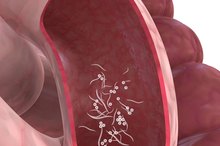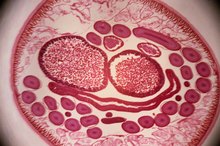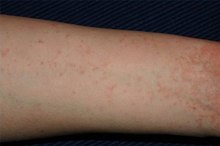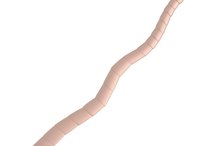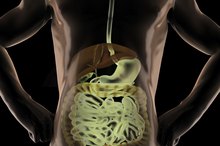Human Liver Fluke Symptoms
Human liver flukes are parasitic worms called trematodes. Infections typically occur from eating infected raw or undercooked freshwater fish or watercress. After ingestion, liver flukes travel from the intestine to the bile ducts of the liver where they mature and live. Liver fluke infection can be asymptomatic or may cause symptoms related to the biliary system (the liver bile ducts and gallbladder). Although liver fluke infections are uncommon in the U.S., they do occur, especially among people who have traveled to areas of the world where these parasites are common.
If you are experiencing serious medical symptoms, seek emergency treatment immediately.
Abdominal Pain
Liver fluke infection can cause pain in the upper right abdomen where the liver is located. Pain is this area is particularly common in the early stages of infection, especially with Fasciola hepatica. The pain corresponds to the flukes making their way from the intestine into the liver. The immature flukes burrow through the liver surface causing pain. Later in the illness, heavy infestation with any of the liver flukes may cause episodic obstruction of the biliary system. Pain in the right upper abdomen is a characteristic symptom during these episodes.
- Liver fluke infection can cause pain in the upper right abdomen where the liver is located.
- Later in the illness, heavy infestation with any of the liver flukes may cause episodic obstruction of the biliary system.
Fever
What Are the Different Types of Roundworms?
Learn More
Infection with liver flukes may cause episodic fevers. Fevers are most common early in the infection, and may reach as high as 104F. Fevers also occur if the liver flukes cause obstruction of the biliary system.
Nausea, Vomiting and Diarrhea
Nausea, vomiting and diarrhea may occur with liver fluke infections. These symptoms are prominent early in the infection and may last for weeks to months 2. Gastrointestinal symptoms typically wane after the initial phase of the infection but may recur later due to inflammation or obstruction of the biliary tract.
Hives
Symptoms of Intestinal Worms
Learn More
Parasitic infections, including those caused by liver flukes, may cause hives. This symptom is triggered by the immune system’s response to invasion by the parasites. Hives are most common early in the illness.
Malaise
Liver fluke infection may cause a general feeling of being unwell; this symptom is called malaise. It is common in the early phase of liver fluke infection. Malaise may recur later in the illness if long-standing infection causes permanent liver damage.
Decreased Appetite and Weight Loss
Long-standing liver fluke infection may cause decreased appetite and weight loss. Infections with liver flukes, especially Fasciola hepatica, may cause liver cirrhosis after many years. Weight loss, jaundice (yellowing of the skin and whites of the eyes), and other signs and symptoms are common with cirrhosis of the liver 2.
Related Articles
References
- Centers for Disease Control and Prevention: Clonorchiasis
- Merck Manual for Health Care Professionals: Clonorchiasis, Signs and Symptoms
- Centers for Disease Control and Prevention: Fascioliasis
- Merck Manual for Health Care Professionals: Fascioliasis
- World Health Organization: Trematodosis
- Centers for Disease Control and Prevention, Emerging Infectious Diseases: Opisthorchiasis from Imported Raw Fish
- Centers for Disease Control and Prevention, Emerging Infectious Diseases: Emerging Foodborne Trematodiasis
- Principles and Practice of Infectious Diseases; Gerald L. Mandell, M.D., et al.; 2004
- American Society of Clinical Oncology. Cancer.Net. Liver Cancer: Symptoms and Signs. Updated 05/2017. https://www.cancer.net/cancer-types/liver-cancer/symptoms-and-signs
- Bosch, X., Molclus, E., and Escoda, O. et al. Unintentional Weight Loss: Clinical Characteristics and Outcomes in a Prospective Cohort of 2677 Patients. .PLoS One. 2017. 12(4):e0175125.
- National Cancer Institute. Adult Primary Liver Cancer Treatment (PDQ)—Patient Version. Updated 12/07/17. https://www.cancer.gov/types/liver/patient/adult-liver-treatment-pdq
- Liver metastases. Canadian Cancer Society
- Liver cancer symptoms. Cancer Treatment Centers of America
- Gkamprela E, Deutsch M, Pectasides D. Iron deficiency anemia in chronic liver disease: etiopathogenesis, diagnosis and treatment. Ann Gastroenterol. 2017;30(4):405-413. doi:10.20524/aog.2017.0152
- Baraldi O, Valentini C, Donati G, et al. Hepatorenal syndrome: Update on diagnosis and treatment. World J Nephrol. 2015;4(5):511-20. doi:10.5527/wjn.v4.i5.511
- Mazzanti R, Arena U, Tassi R. Hepatocellular carcinoma: Where are we?. World J Exp Med. 2016;6(1):21-36.
- American Society of Clinical Oncology. Cancer.Net. Liver Cancer: Symptoms and Signs. Updated 05/2017.
- Bosch, X., Molclus, E., and Escoda, O. et al. Unintentional Weight Loss: Clinical Characteristics and Outcomes in a Prospective Cohort of 2677 Patients.PLoS One. 2017. 12(4):e0175125.
- Mazzanti, R., Arena, U., and R. Tassi. Hepatocellular Carcinoma: Where Are We? World Journal of Experimental Medicine. 2016. 6(1):21-36.
- National Cancer Institute. Adult Primary Liver Cancer Treatment (PDQ)—Patient Version. Updated 12/07/17.
Writer Bio
Dr. Tina M. St. John owns and operates a health communications and consulting firm. She is also an accomplished medical writer and editor, and was formerly a senior medical officer with the U.S. Centers for Disease Control and Prevention. St. John holds an M.D. from Emory University School of Medicine.
